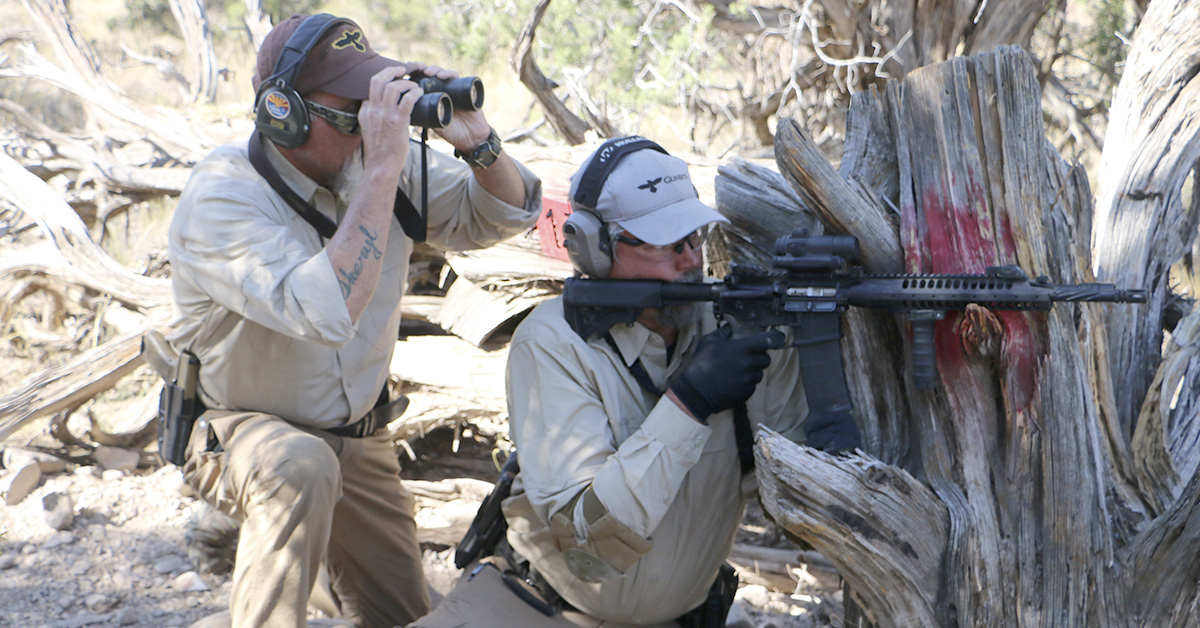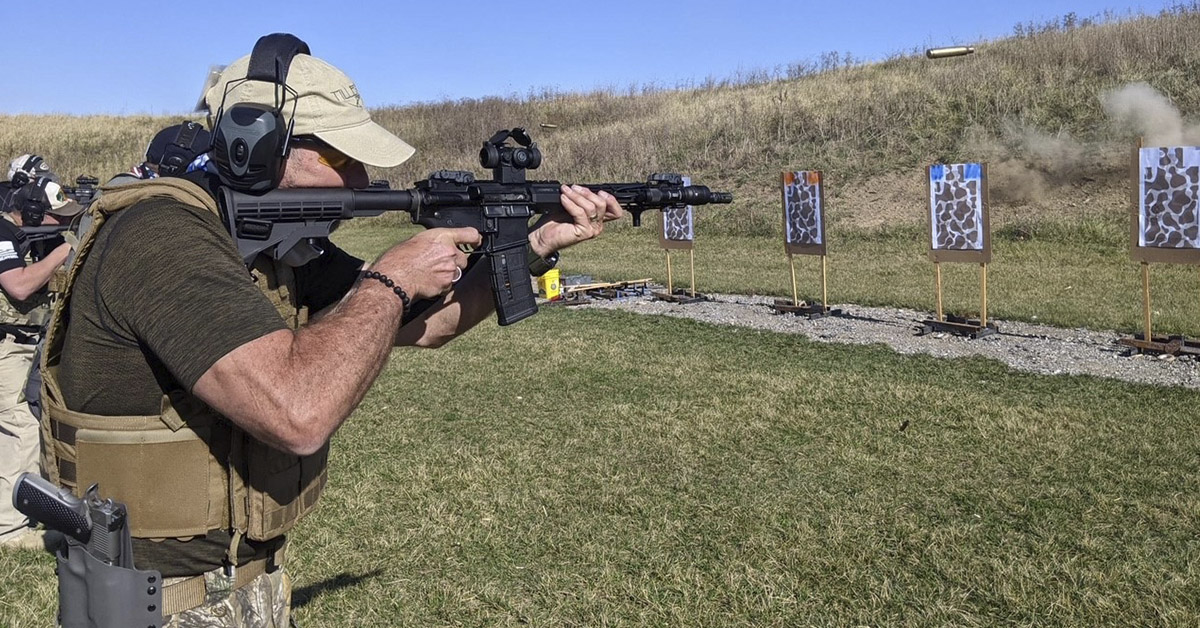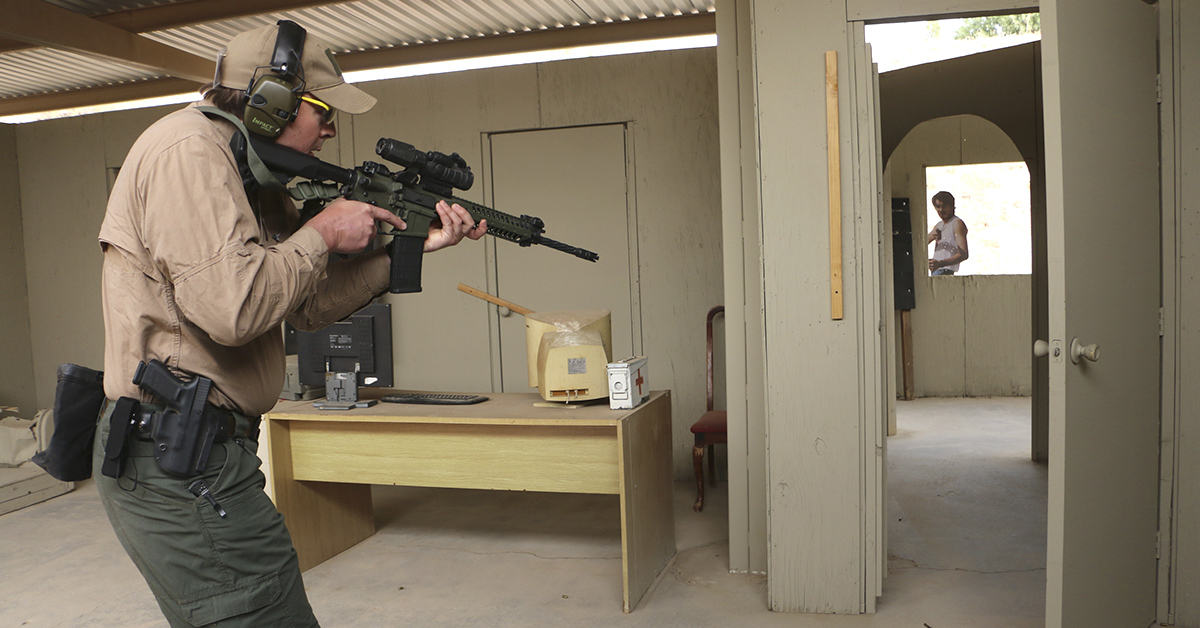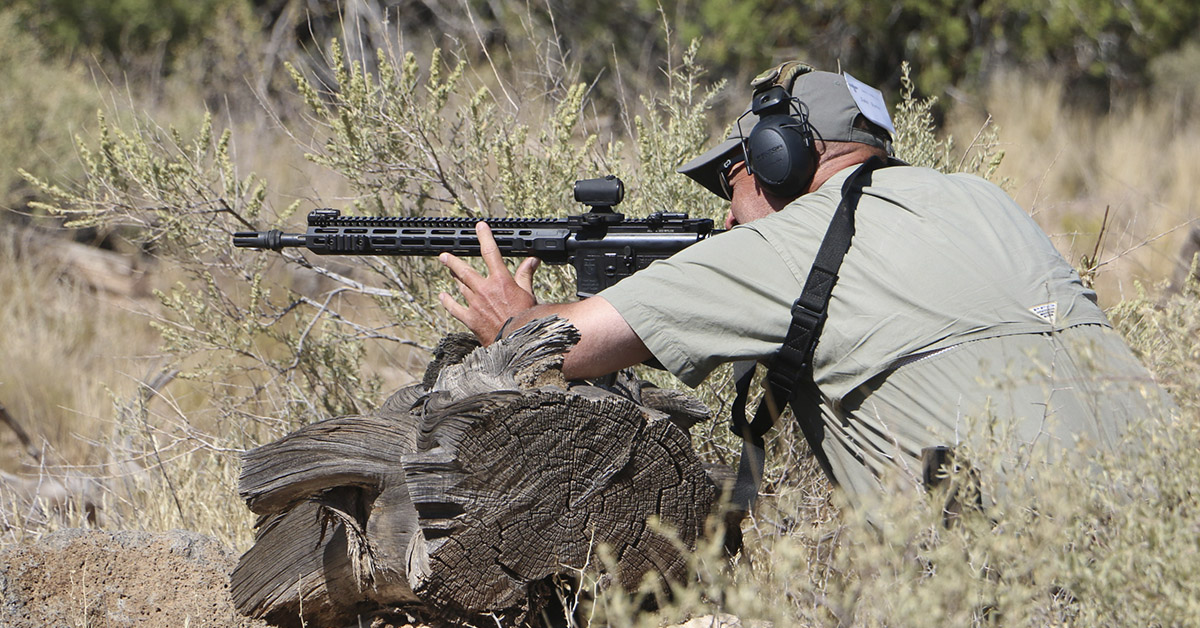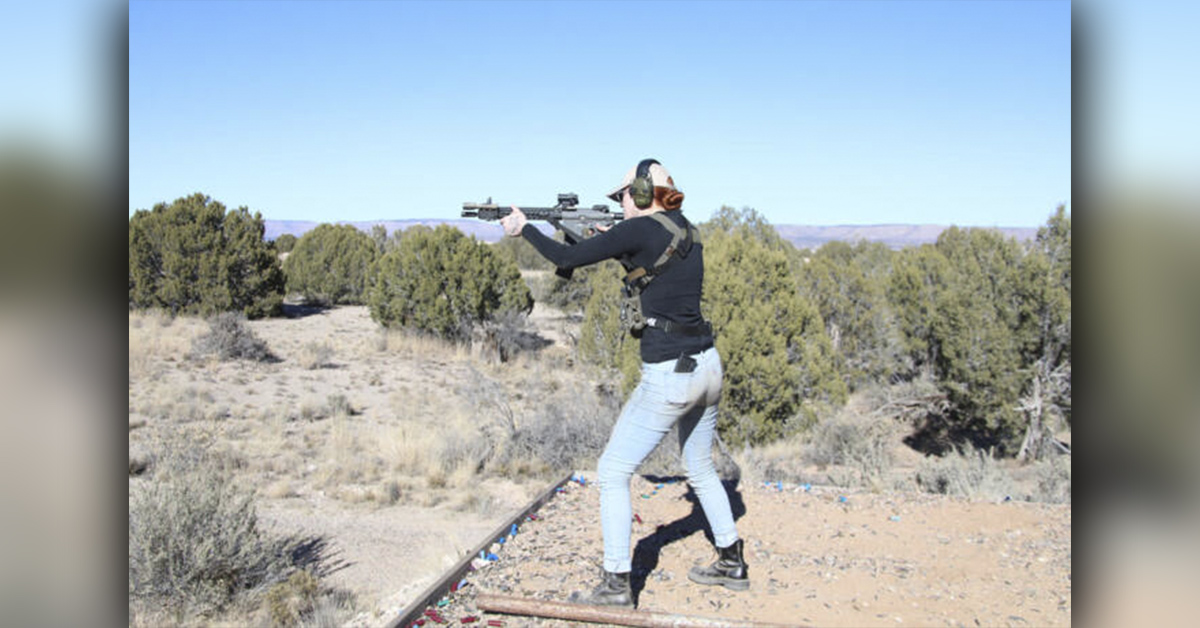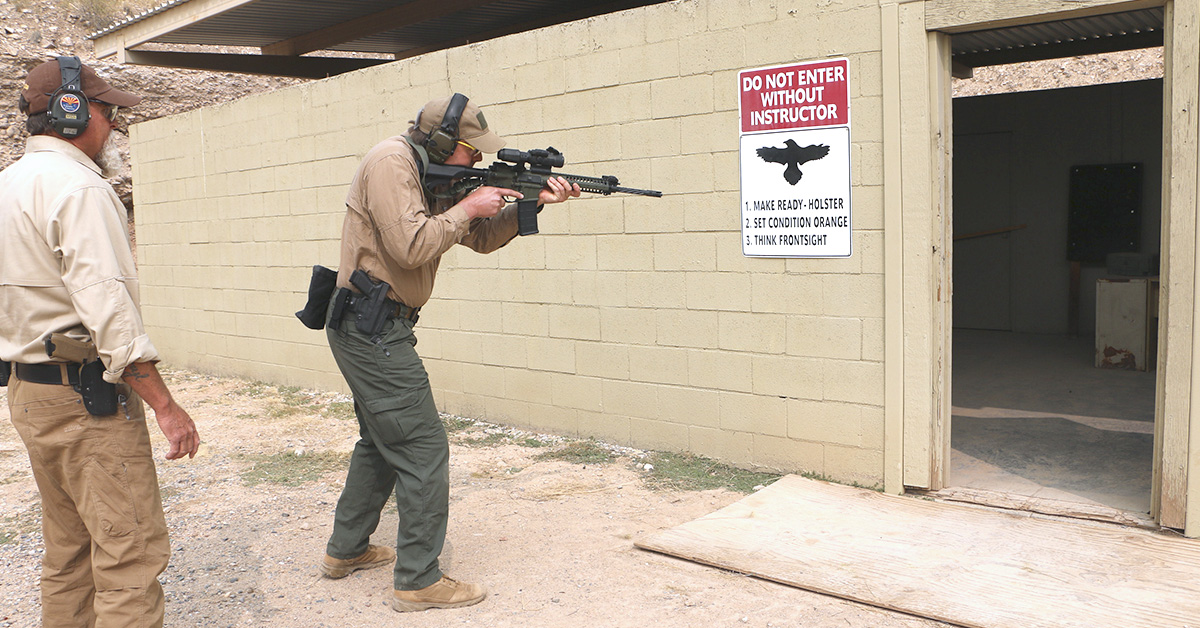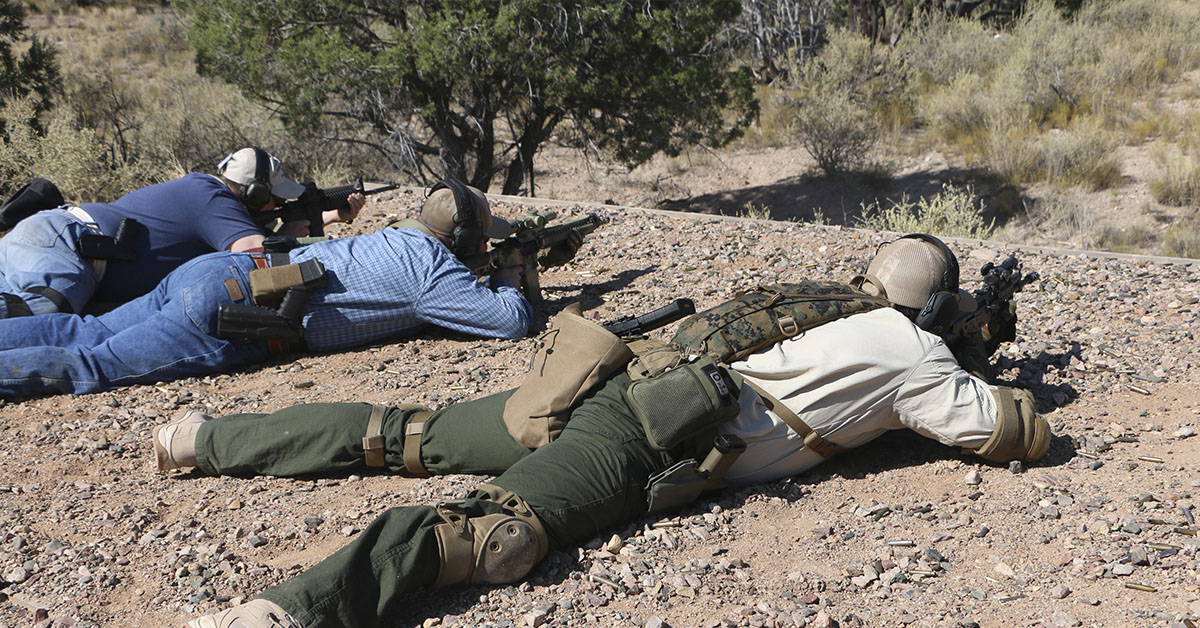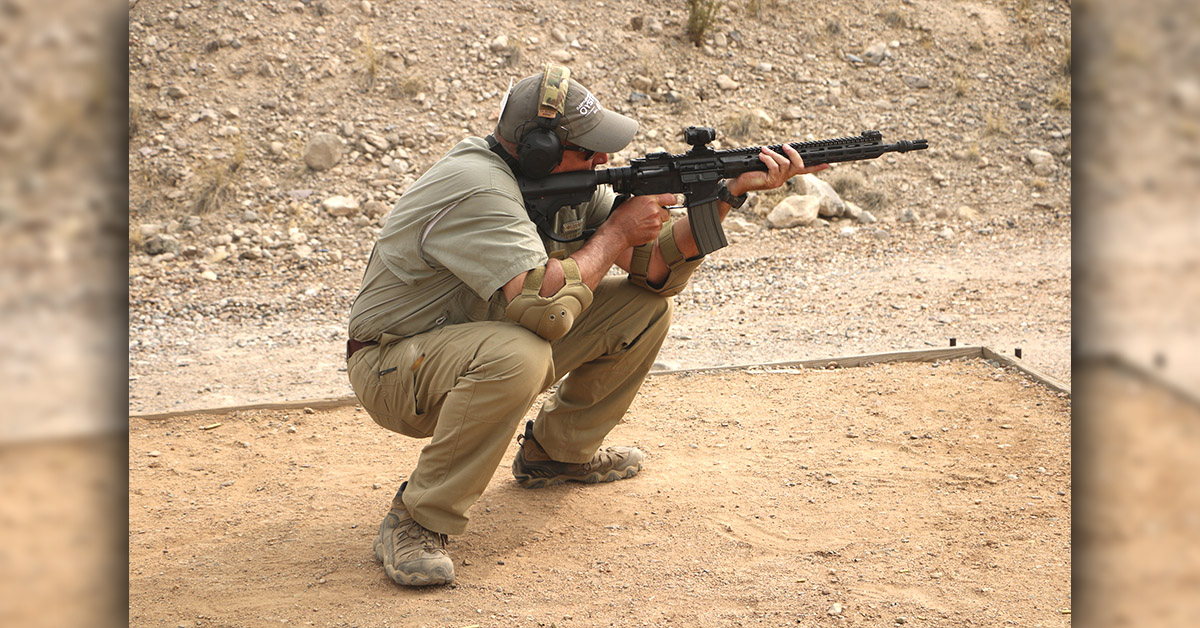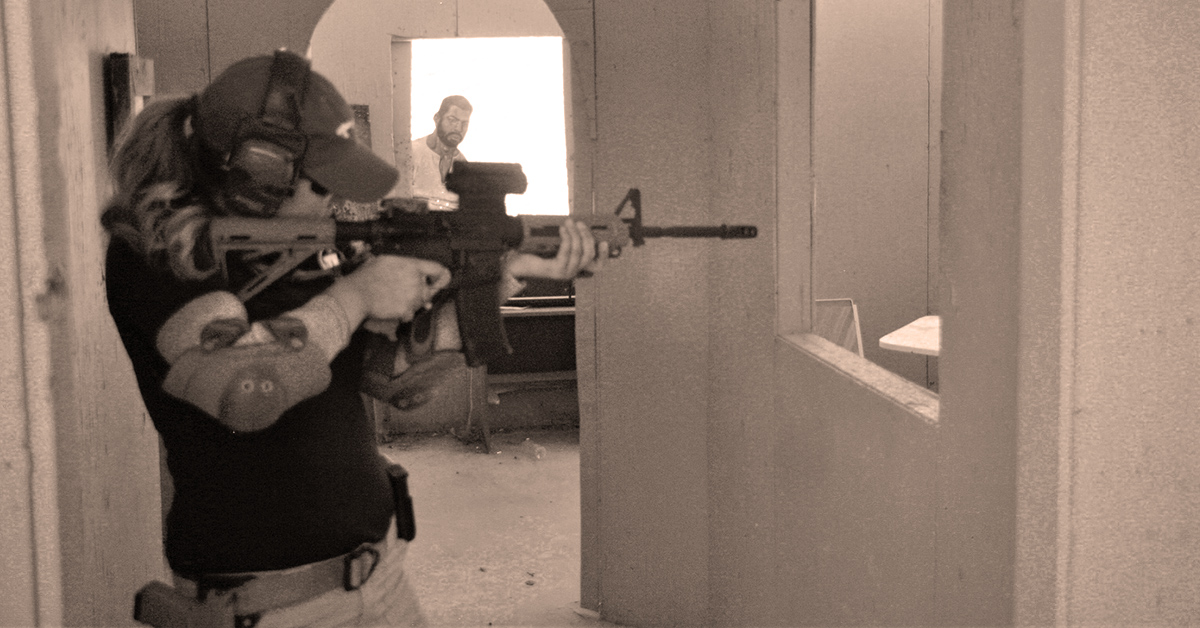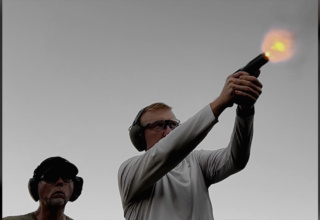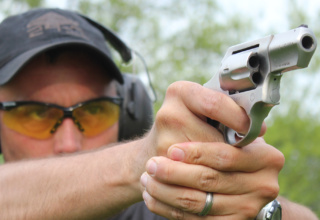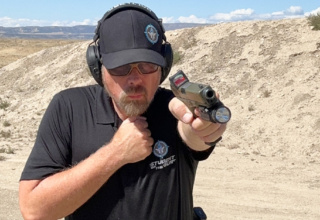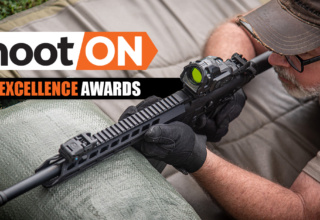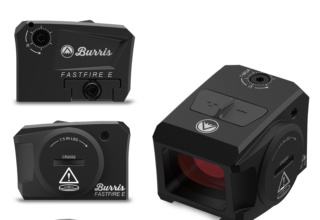In this debut installment of Trainers Talk, we discuss the defensive AR-15 with Gunsite Academy firearms training instructor Lt. Col. Freddie Blish
by the Shoot On staff; photography courtesy Gunsite Academy
It is safe to say that the AR-15 is a widely (and wildly) preferred firearm and a permanent fixture in the United States. Much to the chagrin and the consternation of many in the political class and its anti-2A agitators, the AR-15 is here to stay, falling well within the bounds of the “common use” precedent established by U.S. Supreme Court rulings.
Unfortunately, that doesn’t prevent the hegemonic state types from trying to pry AR-15s from the hands of American citizens. Putting aside the nonsensical “assault weapon” label, President Biden just renewed his administration’s intent to rub out this common-use firearm — 2nd Amendment right to bear or not. In a speech before the House Democratic Caucus Issues Conference on March 1, 2023, Biden said:
“I know I ma- — make some of you uncomfortable, but that little state above me, in Delaware, is one of the — has the highest rate — one of the highest rates of gun ownership. But guess what? We’re going to ban assault weapons again come hell or high water. [Applause.] And high-capacity magazines.“ [Applause.]
With nearly 25 million AR-15s having been produced and sold in the U.S. (24,446,000 between 1990 and 2020 per NSSF collected data), we believe there are more than a few citizens who have an opposing viewpoint to that of Mr. President.
Over the “pandemic years,” new gun ownership, including new AR-15 ownership, skyrocketed in response to personal safety concerns and the visible deterioration of order in our major cities. More people were, for the first time, reaching for the AR-15 as their first line of defense. And rightly so.
Thanks to its modular design, ease of customization, and broad defense and sporting applications, the AR-15 is one of the most adaptable and applicable firearms on the market, and it continues to grow in popularity in the civilian world nearly 60 years after the platform’s adoption by the U.S. Military.
Yet as mainstream as the AR-15 is, the gap between the number of AR-15s in circulation and the number of AR-15 owners who are comfortably and safely proficient in their use is, we’re sure, alarmingly wide. This is not a knock on first-time AR owners — we’ve all been there at some point — but the fumbling and uncertainty we’ve seen from new AR owners at public ranges as they try to learn how to operate their just-out-of-the-box rifles is quite concerning. If they are having this much of a challenge with basic operations, how would they perform in a crisis?
That is why practice and training are so important — not just for new AR owners but also for those who have been successfully shooting ARs for years. Quality training to establish a proper mindset and mechanical skills combined with regular practice to hone those skills are important for any shooter but are vitally important for successful personal defense. And who better to discuss the subject with beginner and veteran shooters alike than an instructor from the most respected firearm training center in the country — Gunsite Academy?
Established by the renowned Lt. Col. Jeff Cooper in 1976, Gunsite Academy employs highly experienced and dedicated instructors to guide students through the pragmatic use of firearms for personal defense based on what the school defines as the Combat Triad: marksmanship, gun handling, and mindset. Gunsite’s course curriculum is extensive, with classes conducted at the academy’s headquarters in Paulden, Arizona, as well as off-site locations in Alabama, Alaska, Colorado, Indiana, Tennessee, and South Carolina.
When we inquired about a Gunsite instructor to participate in our Trainers Talk Q&A and to provide you with a big picture view of the AR as a personal defense firearm, along with some on-the-firing-line training observations, we were pointed to Gunsite Academy Rangemaster and retired USMC Lieutenant Colonel Freddie Blish.
Freddie has served 24 years of military service with multiple combat tours and was deployed globally in operational, instructional, and advisory capacities. His tours include Iraq, Africa, Korea, Thailand, and Latin America. After his retirement from the Marine Corps, Blish served as the Director of Military Business Development for Aimpoint, Inc., where he developed an intensive training program on their use by the US Army Regional Training Center firearms instructors, US Army Mountain Warfare School, USAF Para-Rescue, and I Marine Expeditionary Force Advisory Training Teams. He has worked for LaRue Tactical, and as a private contractor handling high-risk clients domestically and overseas. He has also been a technical advisor pertaining to military optics for several television shows and movies. Currently, he is the owner and CEO of Patriot Products AZ, LLC, the manufacturer of the Combat Sight Tool and the Combat Optic Tool.
– Rob Reaser, Shoot On Editor-in-Chief
The Hardware
SO – As an experienced carbine trainer, what is your opinion of AR-platform rifles for civilian personal defense? Are they the more practical choice for the home defender versus, say, a defensive shotgun or a pistol? What are the pros and cons from your perspective?
Blish – Eugene Stoner’s combat experience as a WWII Marine, combined with his innate genius, helped him design an extremely ergonomic carbine/rifle platform with a very mild recoil. Plus, properly built AR carbines using quality parts, kept lubricated, using good magazines, and shooting quality ammo are extremely reliable and accurate. These factors make the AR an excellent firearm for home and/or self-defense. Additionally, they are relatively easy to learn how to shoot accurately within home defense distances. USCCA is now offering an excellent one-day AR-15 Fundamentals, whereas Gunsite offers more extensive training in the 123, 223, and 556 Advanced Carbine classes.
Pistols are great for personal defense because they are easy to carry, especially concealed; however, terminal ballistics of pistol calibers are not as good as a carbine or rifle caliber. Also, pistols require more training to shoot accurately. The Gunsite 150 or 250 classes are excellent places to start.
Shotguns are great for home defense, as well as personal defense, but managing their recoil can be difficult for smaller people or those without proper training. Shotguns are extremely versatile in their use. The type of shells used (#00 buckshot or slug) dictate the maximum range of effectiveness. This is why they are referred to as a “thinking man’s” gun. The myths about racking the bolt to scare away a threat or just pointing the barrel in the general direction and pressing the trigger while shooting from the hip to hit the threat are just as bad as the advice our current President gave to shoot in the air or through a closed door. Shotguns can be extremely effective and useful for defensive purposes but require proper training. The Gunsite 260 Shotgun class is an excellent place to start.
Finally, pistol and shotgun defensive rounds will typically travel through home interior walls whereas AR platforms shooting .223/5.56 caliber ammunition typically don’t over penetrate the interior and exterior walls of homes. Thus, for all the reasons mentioned above, the AR platform makes for a very effective home defense firearm.
SO – What do you consider to be the optimal AR-platform style for personal defense (M16 rifle clones, M4 carbine clones, or conventional MSRs) and why?
Blish – The best AR-platform style for personal or home defense is an M4-style with a 16-inch barrel length. The Colt 6920 is considered the “standard” to judge other makes and models. Bravo Company, Noveske, Hodge Defense, LaRue Tactical, and Stag Arms are other manufacturers that make reliable ARs using quality parts. For a more budget friendly AR platform, the Ruger AR-556 has proven to be very accurate and reliable during private classes for Ruger engineers at Gunsite.
For those concerned about weight, Kaiser US Shooting Products makes an excellent AR, below five pounds, with the upper and lower receivers made from the same lightweight material that is used on the F-35 Strike Fighter. They currently have a contract with a US Special Operations unit and are in discussions with several foreign military and law enforcement agencies.
The recent popularity of AR pistols makes them an excellent choice for home defense, provided the barrel length is 10.5 to 12.5 inches. Barrels shorter than 10.5 inches typically have reliability issues; however, given the recent ATF re-interpretation of the regulations regarding pistol braces, it might be best to wait until courts have ruled on the issue, or apply for a Short Barrel Rifle Stamp.
SO – If you were asked which caliber AR-15 is best for personal/home defense, what would you suggest and why?
Blish – There are several excellent calibers for an AR-15 with excellent terminal ballistics — .300 Blackout and 6.5 Grendel, for example; However, the caliber that I would recommend is .223 Remington or 5.56 NATO. The reason I recommend .223/5.56 over other calibers is availability and lower cost of the ammo, which means it will be more conducive to training.
I recommend that when purchasing an AR-15 that it has a 5.56 NATO or .223 Wylde chamber. That way, you can use both .223 Remington and 5.56 NATO ammo. There is some excellent defensive ammo in .223/5.56 that have proven terminal ballistics. One is Federal Gold Medal Match 77gr., which is the civilian equivalent to the MK262 Mod 1 ammo used with great effect by Marines in Afghanistan. Also, 55 gr., 60 gr., and 75 gr. Hornady TAP that is used by U.S. law enforcement is very good. The FBI uses Federal 62-gr. Tactical Bonded Hollow Point and their testing protocols are extremely stringent.
SO – Some approach a personal defense AR-15 in terms of “less is more,” preferring to keep things simple, while others feel that every aftermarket add-on increases their performance capability. That said, what do you think is the most practical AR setup for personal defense (e.g., open sights vs red dot vs LPVO, light, laser, drop grip, sling, upgraded trigger, et cetera…or keep it simple)?
Blish – The mission should drive the equipment requirement and individual’s need to ask themselves what is the purpose for their AR-15. Do you live in an urban, suburban, semi-rural, or rural area? Are you using it primarily for home defense or defense of home and property? Will you be using the AR-15 for predator (coyote, feral hog) eradication? At what distance will your local prosecutor consider is justifiable when using an AR-15 for self-defense outside your home…50 yards…35 yards…25 yards? Basically, there is no need for a 3-9x scope on an AR-15 to defend your house in an urban or suburban situation.
I am a firm believer that less is more. In the military, there is an adage that “ounces are pounds and pounds are pain.” If the primary purpose of your AR-15 is home defense, then I recommend keeping the carbine as light as possible.
Thus, a quality red dot like an Aimpoint sight (Micro T-2/H-2, CompM4, CompM5, or PRO) in a quality, standard co-witness 1.51-in. height or 1/3 co-witness 1.725-in. height mount is highly recommended as it allows the shooter to focus on the target versus the front sight.
The latest “cool kid” optic is an LPVO in a 1.93-in. height mount. An LPVO with clear glass and a daylight-usable red dot, like a Swarovski Z6i 1-6X or Leupold Mark 6 1-6X, is great, but you may be purchasing way more capability than is needed. If you aren’t wearing/using night vision devices or wearing a gas mask, then the higher 1.93-in. mount is probably not a necessity for you. If your legal justifiable distance for defense is 50 yards, do you really need a magnified optic — even if it is a 1-4X or 1-6X LPVO?
The next item that I would recommend is a quality weapons mounted light like a Surefire Scout light, a Streamlight ProTac 2.0, or Crimson Trace CWL 202, preferably one with lumens greater than 500. Firearm Safety Rule #4 is “Be sure of your target and what’s beyond.” Thus, the more lumens that allow you to properly identify a threat in low light/no light conditions the better. This, of course, doesn’t negate the need for a quality handheld light for normal searching requirements.
Vertical foregrips are nice when installed at the proper location so that it helps with pulling the carbine firmly back into the shoulder to control recoil; However, they are not a hard requirement.
A good quality tactical sling is an essential part of an AR-15 carbine. Clint Smith has an adage that, “A sling is to a rifle what a holster is to a pistol.” I recommend a quality tactical two-point sling like a VTAC, Vickers Tactical, Redwire Tactical, or a MagPul. The Redwire and MagPul slings have the advantage of converting from tactical two-point slings to single-point slings when necessary.
A good quality trigger can definitely help with improved accuracy when shooting. Two triggers that have proven themselves for reliability and durability are the Geissele SSA and LaRue MBT. We have seen other aftermarket triggers fail during Gunsite 223 and 556 classes, whereas the Geissele and LaRue triggers have not been a problem.
One feature that is definitely not required nor needed on an AR-15 is a muzzle brake. Muzzle brakes are not required to control the “punishing” recoil of .223/5.56. They are brutally loud when used indoors where the sound waves bouncing off the floor, ceiling, and walls multiplies the sound to nearly 8X the original.
SO – Do you have an opinion on the preferred projectile type for a defensive AR?
Blish – Sierra Match King OTM bullets, while designed for match accuracy, have proven themselves pretty effective, especially the 77-gr. SMK OTM at terminal ballistics. Hornady TAP has also proven itself to be very effective.
The Firmware
SO – As a trainer, what are the most common problems areas you see in basic carbine students who walk onto a Gunsite range for the first time (e.g., safety discipline, understanding of operational fundamentals, marksmanship, unrealistic expectations, learned bad form, et cetera)?
Blish – The most common problem area that we see from new students is lack of proper safety discipline — maintaining proper muzzle discipline and keeping the trigger finger off the trigger when the sights are not on target. Additionally, we see improper learned bad techniques or training scars from either watching bad movies, YouTube videos, or self-taught. These common problems can be overcome with a proper attitude from the student to learn the right way.
Another problem we often see is people “married” to bad firearms or equipment because they believed some flashy advertising or it was recommended by an “errornet commando.” We try to assist our students by explaining what firearms and equipment we see perform well during the five-day 223 and 556 Carbine classes. We see just about every type of firearm, optic, sling, magazine, et cetera, and we have observed what is working and not working. We prefer that our students “Buy once, cry once” versus “Trying to save a dime, spend a dollar.”
SO – This may be too large of a question to answer in detail, but what areas of basic carbine instruction do you see students struggling with the most and what are the solutions you present to them?
Blish – One of the biggest issues we are seeing with our students, not just in the carbine classes, is physical fitness and agility. While there are no hard physical requirements or abilities to attend any of the classes at Gunsite, what we have been seeing is the difficulty of some students to get into prone, sitting, kneeling, or squatting positions. Also, students not used to standing all day with an ~8-lb. carbine and four or more loaded magazines, their backs can feel pretty sore by the end of the day. As a society, we could all do a better job of taking care of our “combat chassis.”
From a learning perspective, some of the things we see are students failing to apply mechanical offset when shooting at targets at close range (15 yards and closer), proper manipulation of the safety/selector switch, and clearing Type I, II, and III stoppages. We spend a lot of time firing numerous repetitions of each of those problems to help develop “unconscious competence” with our students to overcome these issues.
SO – What advice can you give to the aspiring defensive carbine student who does not currently have the means or the time to receive formal training at a facility such as Gunsite but wishes to become more proficient in using their AR-15 for defensive purposes in the meantime?
Blish – Panteao Productions has an excellent video called Gunsite 223, which is available from the Gunsite Pro Shop for $10. Another excellent option is the new one-day USCCA AR-15 Fundamentals course.
SO – We have found dryfire training systems like the Mantis Blackbeard, for example, to be an excellent and cost-effective way to hone basic marksmanship skills. Are dry-fire exercises something you recommend to students?
Blish – Yes, we are big believers in dry practice. Notice I used the words “dry practice” instead of dryfire. It may seem like semantics, but dry practice is a much more definitive term for what the student is doing. A student can significantly improve the efficiency of carbine presentation from low, high, and close ready, tactical and speed reloads, and Type I, II, and III stoppages. Couple that with an excellent dry practice device like that from Mantis and students can improve their skills at a very low cost.
Closing Thoughts
SO – Taking the 30,000-foot view, what advice or considerations would you give someone who is looking to buy an AR for personal defense?
Blish – An AR, or any firearm, is just a tool. It will only work as well as the student is willing to put in the time and effort to properly develop the skill sets to use that tool effectively. Additionally, it is important for people seriously interested in personal defense to spend time developing and improving their combat mindset — developing situational awareness regarding their surroundings, as well as awareness of criminal pre-incident indicators. Again, the Gunsite Pro Shop has an excellent video by Jeff Cooper on Mental Conditioning for only $10.00. Of course, Jeff Cooper’s book To Ride, Shoot Straight, and Tell the Truth covers mindset very well.
Editor’s Note: We want to thank Gunsite Academy and Lt. Col. Blish for this valuable insight into the real-world application of the AR-15 as a personal defense firearm. If you want to learn more about Gunsite Academy’s course offerings, visit Gunsite.com.
Check out the next installment of Trainers Talk when we explore the defensive shotgun.
- Shoot ON’s Annual Excellence Awards - December 12, 2025
- MTM Case-Gard Introduces Compact Carbine Rifle Case - November 26, 2025
- Burris FastFire E Enclosed Emitter Red Dot Debuts - November 26, 2025

